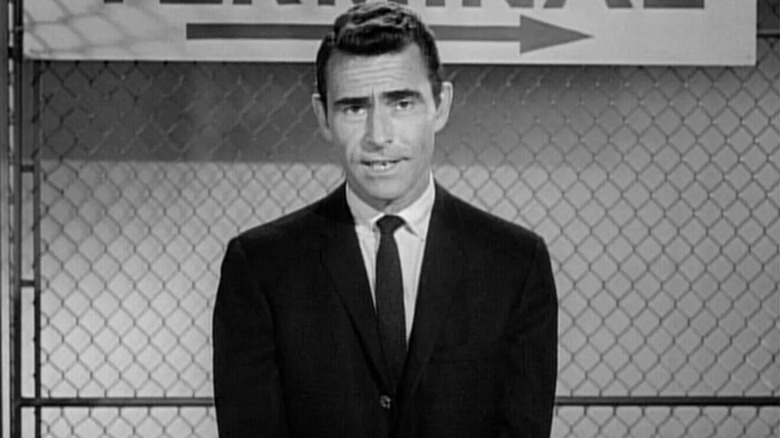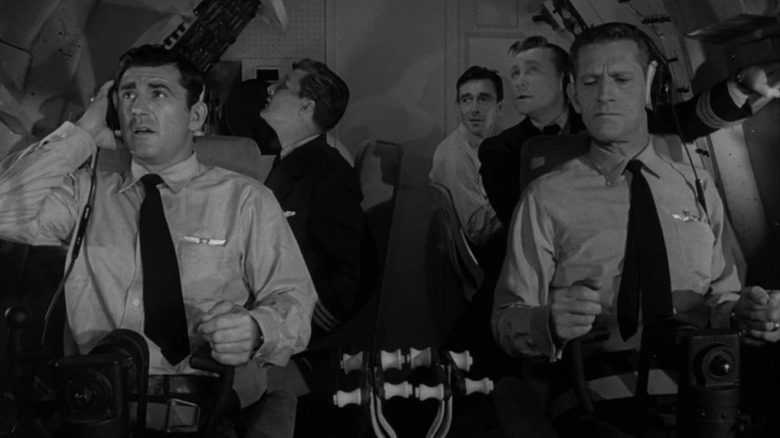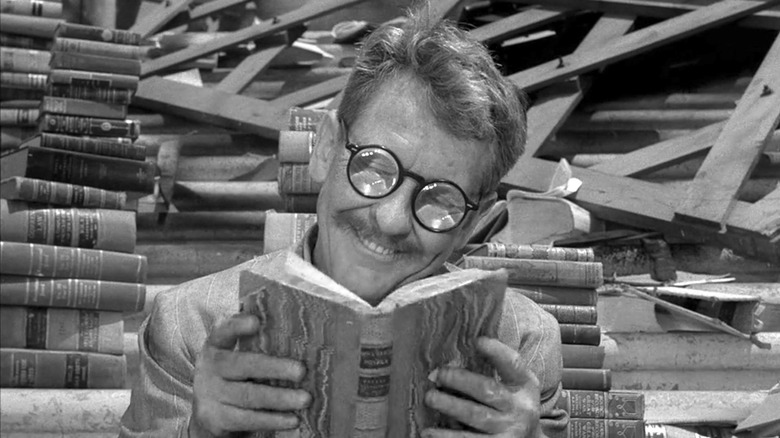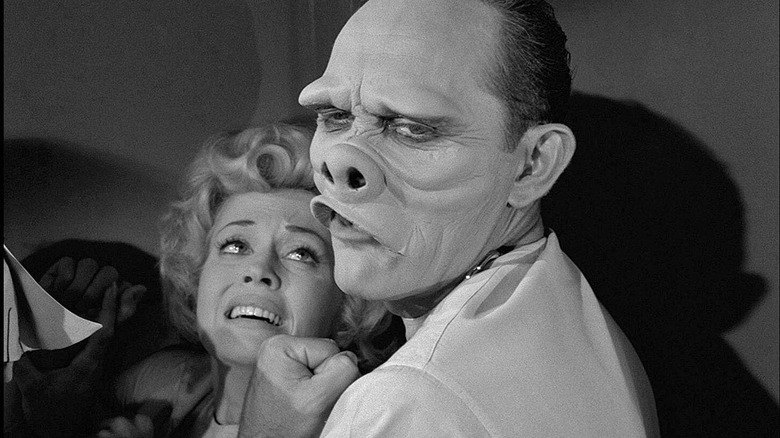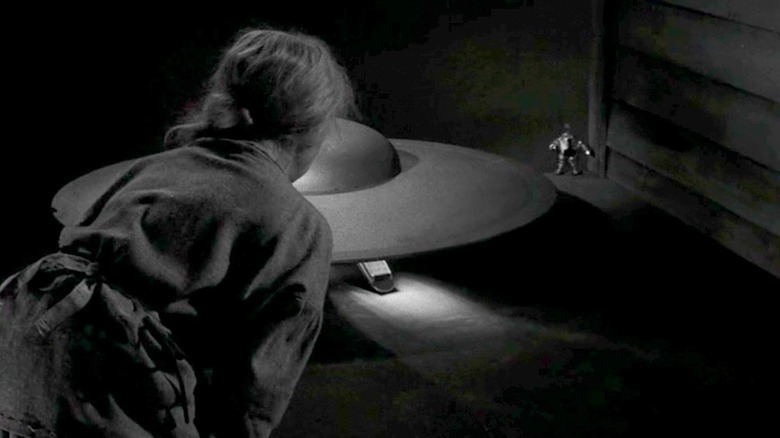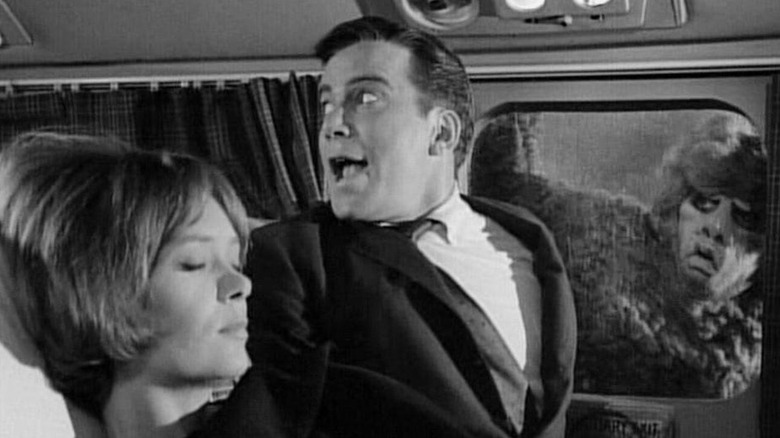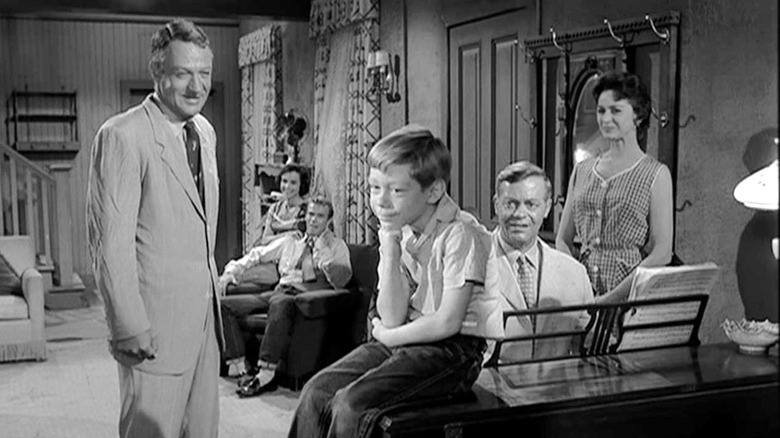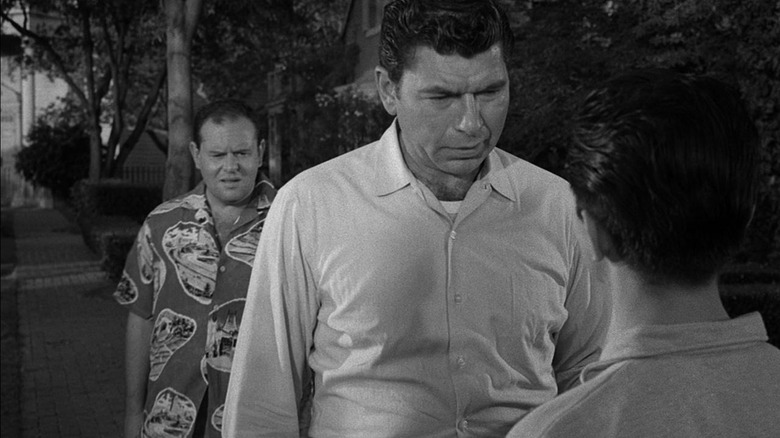The Twilight Zone's 7 Most Notable Episodes, Ranked
Over 60 years after its cancellation, "The Twilight Zone" still commands an intense fascination. Rod Serling's iconic anthology series dabbled in science fiction, horror, and fantasy, crossing the genre streams and delivering a kind of imagination and filmmaking that was uncommon in the late '50s and early '60s. That's why we're still talking about it right now — few shows from that era have aged so well, and so powerfully. Serling and his team rarely just told a spooky or exciting story (although they were so good at doing just that). Instead, they wrapped the genre storytelling around bigger ideas: political commentary, social justice, and what it means to be human. It's easy to say that "The Twilight Zone" was decades ahead of its time, but it really does feel like it exists in its own pocket universe (one that allows it to feel as timeless and as powerful as ever).
When I sat down to craft this list of the most notable episodes of the series, I made the conscious decision to leave off my niche personal favorites. The weirder, more obscure episodes that I treasure weren't part of the conversation. As the headline here implies, this is a list of the biggest and the most noteworthy; the episodes that truly sum up the everlasting appeal of "The Twilight Zone." If you're already a fan, you've seen these a dozen times. If you're a newbie, consider this list a starter pack. Watch these seven episodes, and you'll find yourself compelled to binge the rest of this weird, wonderful, scary, sentimental, smart, funny, twisted, and altogether brilliant series. It's only some of the best television ever made.
7. The Odyssey of Flight 33
"The Odyssey of Flight 33" is maddening and mysterious by design, a classic example of a high-concept science fiction story that somehow manages to get away with a deliberately low-concept execution. It's never made entirely clear how or why the airplane of the title is traveling through time, first to the prehistoric age (complete with stop-motion dinosaurs!) and then to 1939. It's just a run of superb bad luck. A passenger jet happened to be in the wrong place at the wrong time and now the pilots and passengers have to face the impossible ... and reckon with the fact that they're running out of fuel and have no obvious way home.
With the story confined to the plane's interior, Rod Serling's script forces our imagination to do the legwork. We're as trapped and helpless as the passengers, and we can only imagine what wonders or terrors lurk beyond the clouds during each time jump. Infamously, the episode concludes without the satisfaction of a proper ending. We don't know if Flight 33 gets home. But the fact that we don't see where they end up puts a brick in your stomach. If they had a happy ending, the series would've shown us. Instead, we're spared witnessing a tragedy.
6. Time Enough at Last
The first great episode of "The Twilight Zone," "Time Enough at Last" is the kind of television episode so famous that people who have never seen a second of the series probably know the punchline. Legendary character actor Burgess Meredith turns in one of his best performances as a nebbish with only one interest in life: reading. His love of literature derails his job and his relationships, but thankfully, nuclear war clears his life of those pesky details. The sole survivor of a devastating H-bomb attack (he was reading in a highly protective bank vault when it was dropped), he now finds himself alone — no more bosses and wives and customers. Just him, plenty of canned food, and all the books in the ruined world. Time enough at last, indeed.
If you don't know the final moments of the episode (and how could you not?), I'll leave it for you to discover. "The Twilight Zone" was often more optimistic and hopeful than its reputation suggests (Rod Serling was just as much of a softie as he was a cynic), but that's not the case here. The script drops a literal bomb at the halfway point, but then it drops another in the final moments, one so shattering, so bleak, and so darkly funny that you don't know whether to gasp or laugh. Over 60 years later, the final moments of "Time Enough at Last" are capable of eliciting any number of reactions from a viewer. Personally, I guffaw, but only because it hurts too much to not laugh.
5. Eye of the Beholder
Here's another episode of "The Twilight Zone" with a twist ending perhaps more famous than the episode itself. But "Eye of the Beholder" is classic for reasons beyond its big climactic reveal. While the message here may read a wee bit basic to a modern viewer, the sheer jolt of the reveal, and the slow burn leading to it, retains a power that somehow remains undiminished. Debate it all with your buddies after the credits roll, but don't deny that you spent the entire episode leaning forward, fully absorbed in the mystery as it unraveled.
And it all works because "Eye of the Beholder" is a superbly directed episode of television and one that showcases just how experimental and bold "The Twilight Zone" was willing to be with its visuals during an era where television generally adopted a fast, dirty, point-and-shoot aesthetic. Director Douglas Heyes' wry use of shadows and framing (not to mention the carefully directed actors, whose voices do the work since their faces remain hidden for much of the action) feels experimental by modern standards and downright shocking for the '60s. Few TV shows have ever trusted their audience to just roll with such a brazen visual decision quite like this. It paid off. We're still talking about it now.
4. The Invaders
Would the career of director M. Night Shyamalan exist without "The Twilight Zone"? I'm only jesting slightly here — episodes like "The Invaders," with its brilliant rug-pull of a twist ending, easily paved the way for movies like "The Sixth Sense" and "Signs." Written by sci-fi and horror legend Richard Matheon, this is another example of the series breaking from traditional norms and getting borderline experimental. In this case, an alien invasion story with a single lead character who doesn't have any spoken dialogue. That big swing is supported by the casting of that character — the legendary character actor Agnes Moorehead is unforgettable here.
Moorehead plays an unnamed woman living in a decrepit, isolated farmhouse who finds herself accosted by tiny alien invaders who land their UFO on her roof, invade her home, and proceed to terrorize her until she fights back. As a thriller, the episode is top-notch — a home invasion horror story with a sci-fi twist and a pinch of "Gremlins" before "Gremlins" was even a thing. But it's the final reveal, the nature of the invaders and their origin, that seals the deal and makes this episode an all-timer. Some of the best "Twilight Zone" episodes get you so invested in the filmmaking, the craft, and the characters that you forget to look for the twist or the message. "The Invaders" surprises you like no other.
3. Nightmare at 20,000 Feet
Another banger from writer Richard Matheson, "Nightmare at 20,000 Feet" is so famous, its iconography so deeply carved into modern pop culture, that you'd be forgiven for assuming it's lost some of its power. Nah. Director Richard Donner, years before he'd direct blockbusters like "Superman" and "Lethal Weapon," struts his stuff behind the camera and delivers something so inherently scary and primal that no amount of overexposure can dilute it.
You probably know the setup. William Shatner plays a nervous flier (to put it mildly) who sees ... something on the wing of the aircraft mid-flight. No one believes him. Paranoia escalates. He takes matters into his own hands. And Shatner, never a stranger to Acting with a capital "A," really brings the wild goods. Thankfully, the situation is terrifying enough to warrant the size of his performance. Even those disappointed with the look of the creature in question (it's a bit hokey) can't deny the chilling power of the rest of the episode, which ratchets up the tension to unbearable levels.
2. It's a Good Life
Here it is: the single scariest episode of "The Twilight Zone" ever made. Although Rod Serling's adaptation of Jerome Bixby's short story loses some of the nastier and wilder edges that make the original one of the greatest horror stories ever written, the core conceit remains as frightening and unsettling as ... well, as frightening and as unsettling as anything ever produced. Even Serling's opening and closing narration seems at a loss to explain what goes down in "It's a Good Life." It's just a terrifying concept, executed to perfection.
The episode drops the viewer into a day in the life of a community under the total control of a young child born with extraordinary psychic powers. He can manipulate reality to his will but doesn't have the maturity to use it responsibly and no adult has lasted long enough to instill a moral code into him. Instead, he's surrounded only by the survivors, those who smile and nod and bend to his every whim. Or else they get sent to "the cornfield." And no one comes back from the cornfield. It's a brief tour of a special hell and one from which there is no escape.
As Serling's closing narration states: "No comment here, no comment at all." "It's a Good Life" speaks for itself.
1. The Monsters are Due on Maple Street
If you had to select one episode of "The Twilight Zone" that sums up everything the show does well, and showcases everything it was capable of doing, there is only one option. "The Monsters are Due on Maple Street" is a stone-cold classic. A slow-burn tale of terror. A piece of high-minded science fiction. A parable built upon brutal, incisive political commentary. And yes, a big twist ending that redefines everything you've just witnessed. It's the total package.
And like many episodes of the series, it has such a low-key, deceptively simple start: A suburban neighborhood loses power after what appears to be a meteorite flies overhead. But cool heads start to turn hot as the neighbors gather to determine what happened and come to the conclusion that something sinister, and perhaps alien, is afoot. Social constructs crumble. Violence breaks out. The monsters aren't an external threat — they were lurking within our own selves the entire time.
The worst episodes of "The Twilight Zone" are those that preach a social message without delivering the genre bona fides to back it all up. But "The Monsters are Due on Maple Street" is perfect. The final lesson lands with such force because of the terror we've just experienced. We buy it because we saw the truth with our own eyes.
